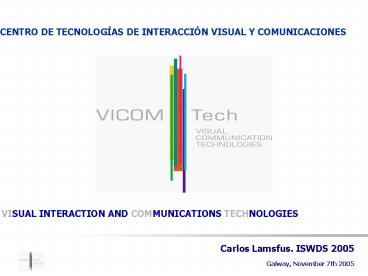CENTRO DE TECNOLOG - PowerPoint PPT Presentation
Title: CENTRO DE TECNOLOG
1
CENTRO DE TECNOLOGÍAS DE INTERACCIÓN VISUAL Y
COMUNICACIONES
VISUAL INTERACTION AND COMMUNICATIONS TECHNOLOGIES
2
Re-use and alignment of ontologies the
art-E-fact ontology as an extension of the CIDOC
CRM
- Carlos Lamsfus, María Teresa Linaza and Tim
Smithers
3
Introduction The Context
- Information exchange
- Knowledge sharing
Internet, Ontologies
- Different systems (technical)
- Different culture /methodology/ languages
(semantic)
Interoperability
- Pursue a culture of re-use of already exiting
work - Contribute to standards
Standards
4
Presentation Overview
- Introduction and Objectives
- Previous work
- The art-E-fact project and ontology
- The CIDOC CRM ontology
- art-E-fact vs. CIDOC CRM -gt Differences
- Alignment of the art-E-fact and CIDOC CRM
ontologies - Conclusions
5
Previous work the art-E-fact project (IST 2001
-37924)
Create a generic platform for Interactive
Storytelling in Mixed Reality that allows artists
to create artistic expressions in an original way
within a cultural context between the virtual and
the physical reality
- Develop a generic platform for interactive
storytelling - Facilitate access to a knowledge database of
cultural and artistic material - Develop an Authoring-Tool (from scratch) that
allows artists to create interactive stories
(content, virtual characters, background and
interaction metaphors) - Access to the content databases
6
Previous work the art-E-fact ontology
- The art-E-fact ontology
- For authors to get a general idea of the content
- Reflect relations among concepts that are not
shown in the database
- The Content Browser
- Efficient and effective access and navigation
through the concepts - To get to know and discover what there is
available - Access to the content database
7
Previous work the CIDOC CRM(I/II)
ONTOLOGY
B
A
8
Previous work the CIDOC CRM (II/II)
- Serve as common language for domain IT experts
and developers - Support the implementation of automatic data
transformation algorithms from local to global
structures without loss of meaning - Exchange and integration of heterogeneous
scientific documentation of museum collections - Scientific documentation -gt information described
by CIDOC CRM as sufficient for academic research - Museum collections -gt collections, sites,
monuments, etc.
9
Presentation Overview
- Introduction and Objectives
- Previous work
- The art-E-fact project and ontology
- The CIDOC CRM ontology
- art-E-fact vs. CIDOC CRM -gt Differences
- Alignment of the art-E-fact and CIDOC CRM
ontologies - Conclusions
10
art-E-fact vs. CIDOC CRM -gt differences
Similarities
Differences
- Both ontologies reflect a (serious) commitment to
the expression of common concepts underlying data
structures used by their users
- The art-E-fact ontology was motivated by the need
to describe added-value content for the creation
of stories - The CIDOC CRM ontology focuses on documentation
processes among cultural institutions, motivated
by the need to share information
11
art-E-fact vs. CIDOC CRM -gt differences
CIDOC CRM
art-E-fact
- SCOPE all the information required for the
scientific documentation of cultural heritage
collections -gt information exchange - CIDOC CRM focuses on curated knowledge of museums
- The CIDOC CRM is intended to cover contextual
information, e.g. historical, geographical and
theoretical background
- SCOPE the ontology is not devoted to
documentation, but to content description and
comprehension -gt semantic index - art-E-fact focuses on content generation by
artists - The art-E-fact ontology takes into account
different levels of knowledge in order to provide
rich content to build interactive stories
12
Presentation Overview
- Introduction and Objectives
- Previous work
- The art-E-fact project and ontology
- The CIDOC CRM ontology
- art-E-fact vs. CIDOC CRM -gt Differences
- Alignment of the art-E-fact and CIDOC CRM
ontologies - Conclusions
13
Alignment of the art-E-fact and CIDOC CRM
ontologies (I/III)
- Merging vs. Alignment (incorporation) of
ontologies - Questions
- Does the art-E-fact ontology need to be a CRM
extension? - What would we like to do with the extended
version? - What do we want to support people doing?
- Alignment semi-automated rule-based process
- Tool -gt to be selected yet
- Ontology language OWL DL
- Alignment language RWL (http//www.wsmo.org/wsml/
wrl/wrl.htmlwsml)
14
Alignment of the art-E-fact and CIDOC CRM
ontologies (II/III)
CIDOC CRM
art-E-fact
- Understand how the art-E-fact ontology is related
to the CRM (knowledge levels) - Identify CRMs part we want to map to art-E-fact
- Try to find a CRM subgroup and match it
(semantically) as identities
15
Alignment of the art-E-fact and CIDOC CRM
ontologies (III/III)
- WRL (Web-based Rule Language)
- Derived from the ontology component WSML
- Rule-based ontology language (OWL description
logic language)
- Translate the art-E-fact ontology into OWL DL
- Using WRL identify common concepts
16
Presentation Overview
- Introduction and Objectives
- Previous work
- The art-E-fact project and ontology
- The CIDOC CRM ontology
- art-E-fact vs. CIDOC CRM -gt Differences
- Alignment of the art-E-fact and CIDOC CRM
ontologies - Conclusions
17
Conclusions
- Technology tending to standards -gt enable
information exchange - The art-E-fact and CIDOC CRM ontologies
- Definition, comparison, differences -gt
conclusions - Research on semantic-based rule languages
- Contribute in general to the standardization of
processes as well as to standards - Concrete example of the application of the
mapping process
18
CENTRO DE TECNOLOGÍAS DE INTERACCIÓN VISUAL Y
COMUNICACIONES
VISUAL INTERACTION AND COMMUNICATIONS TECHNOLOGIES































